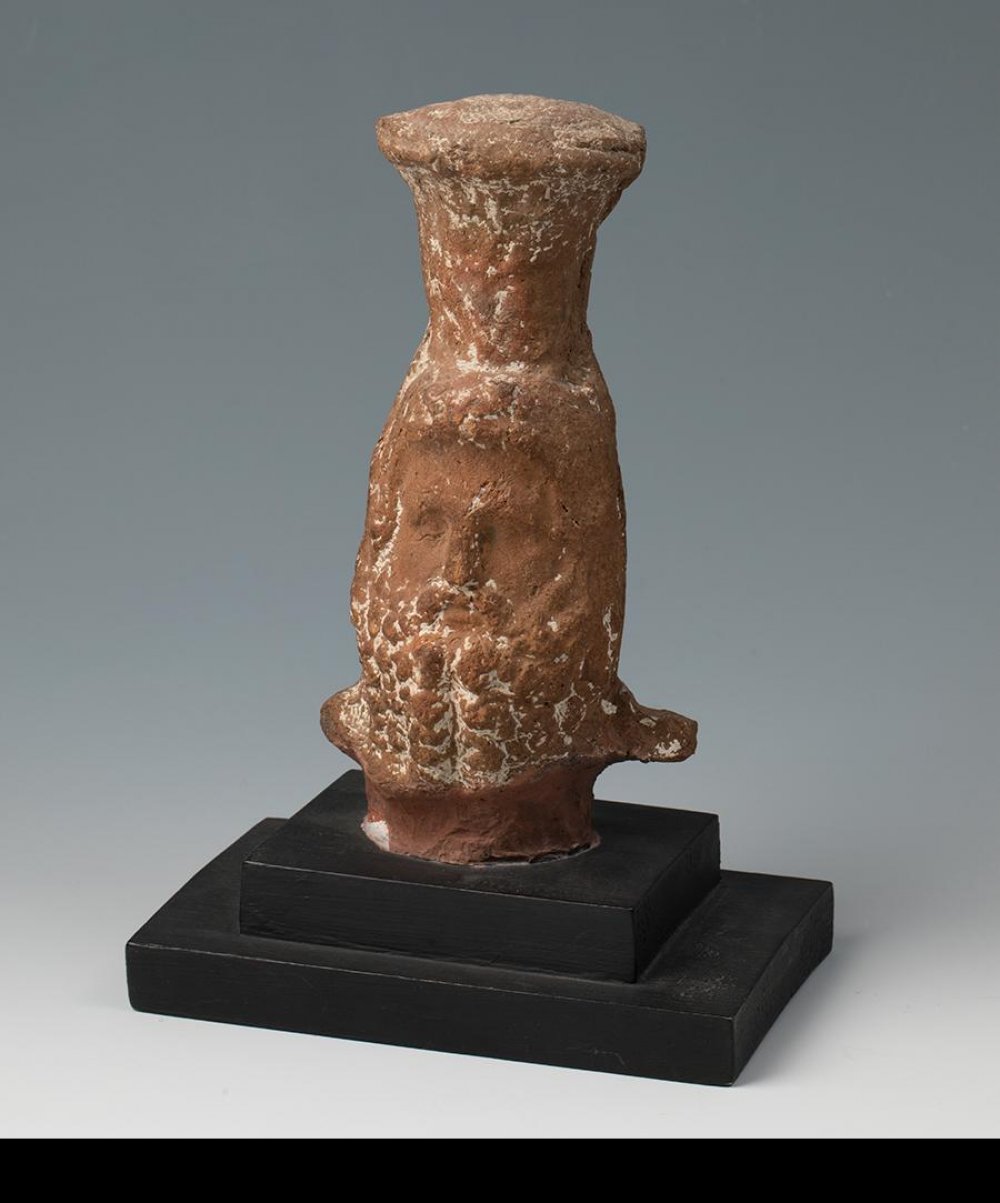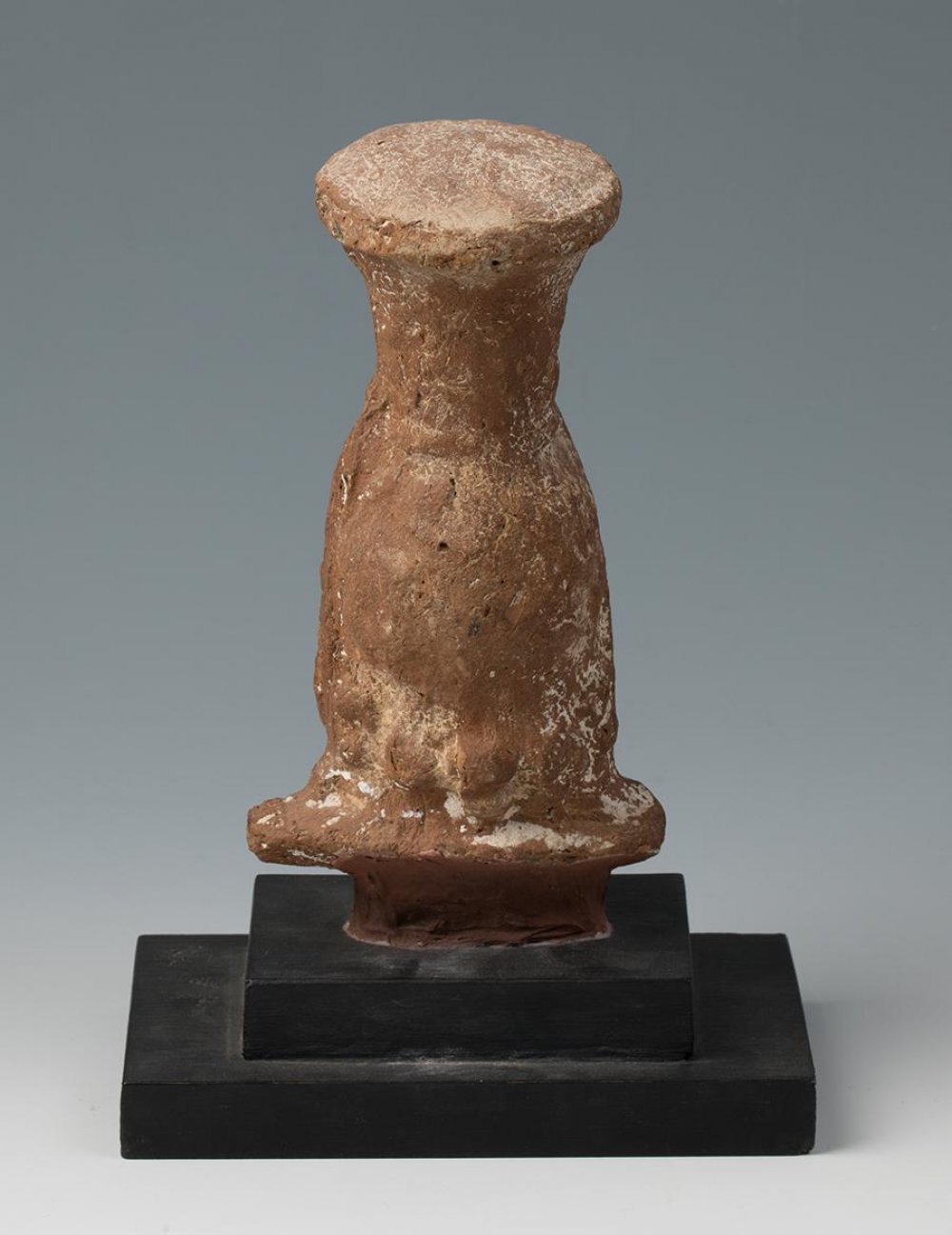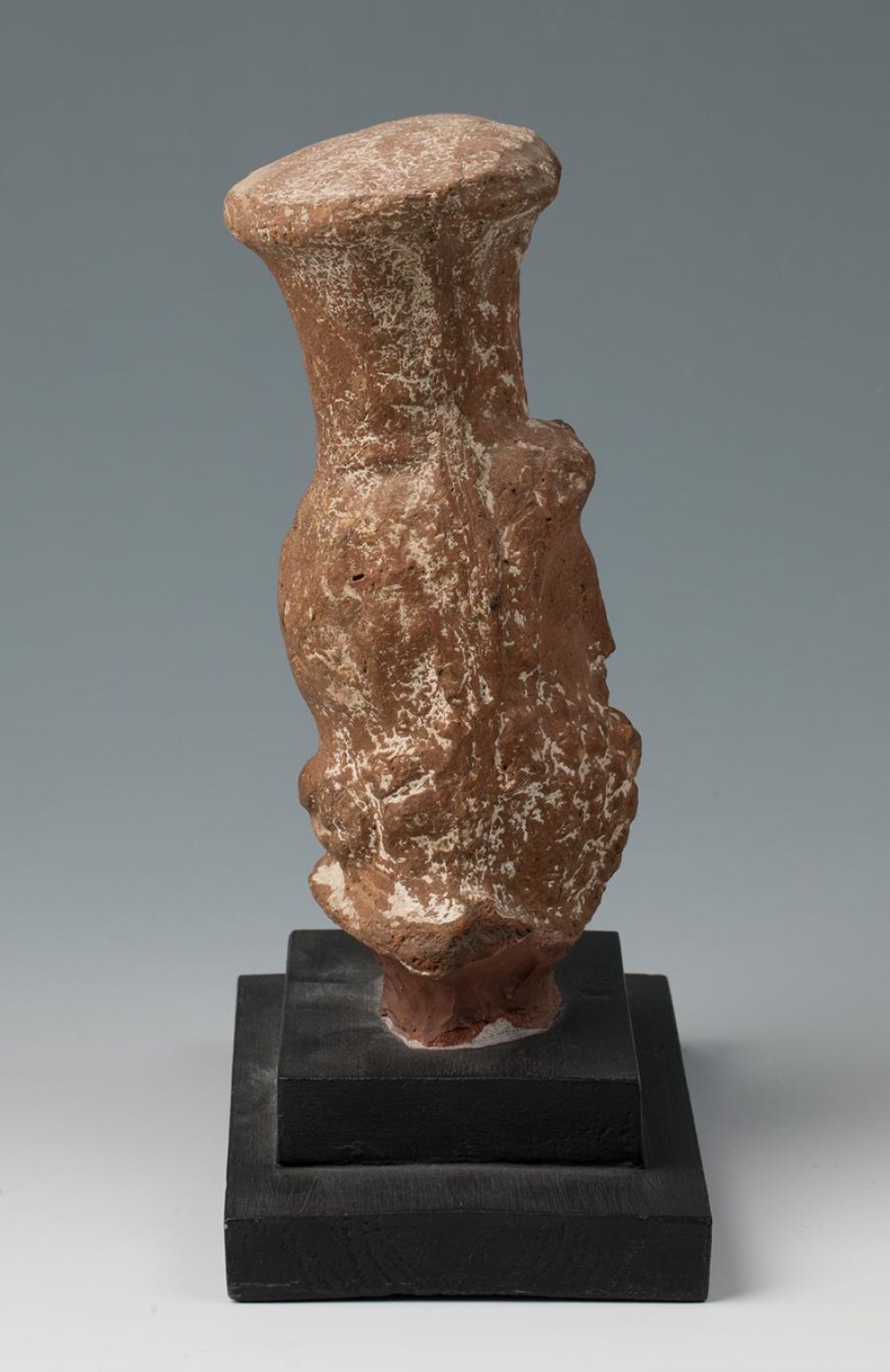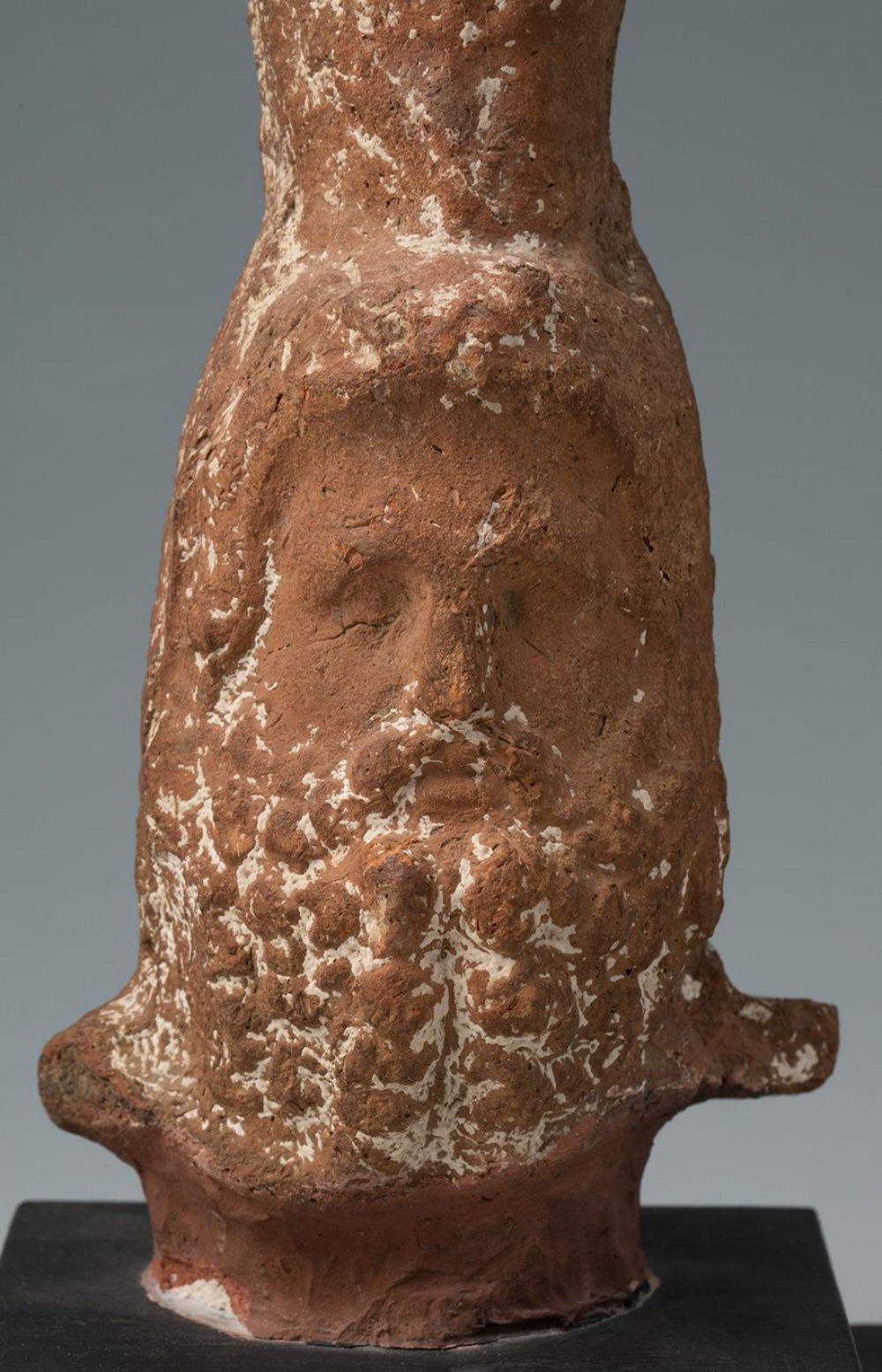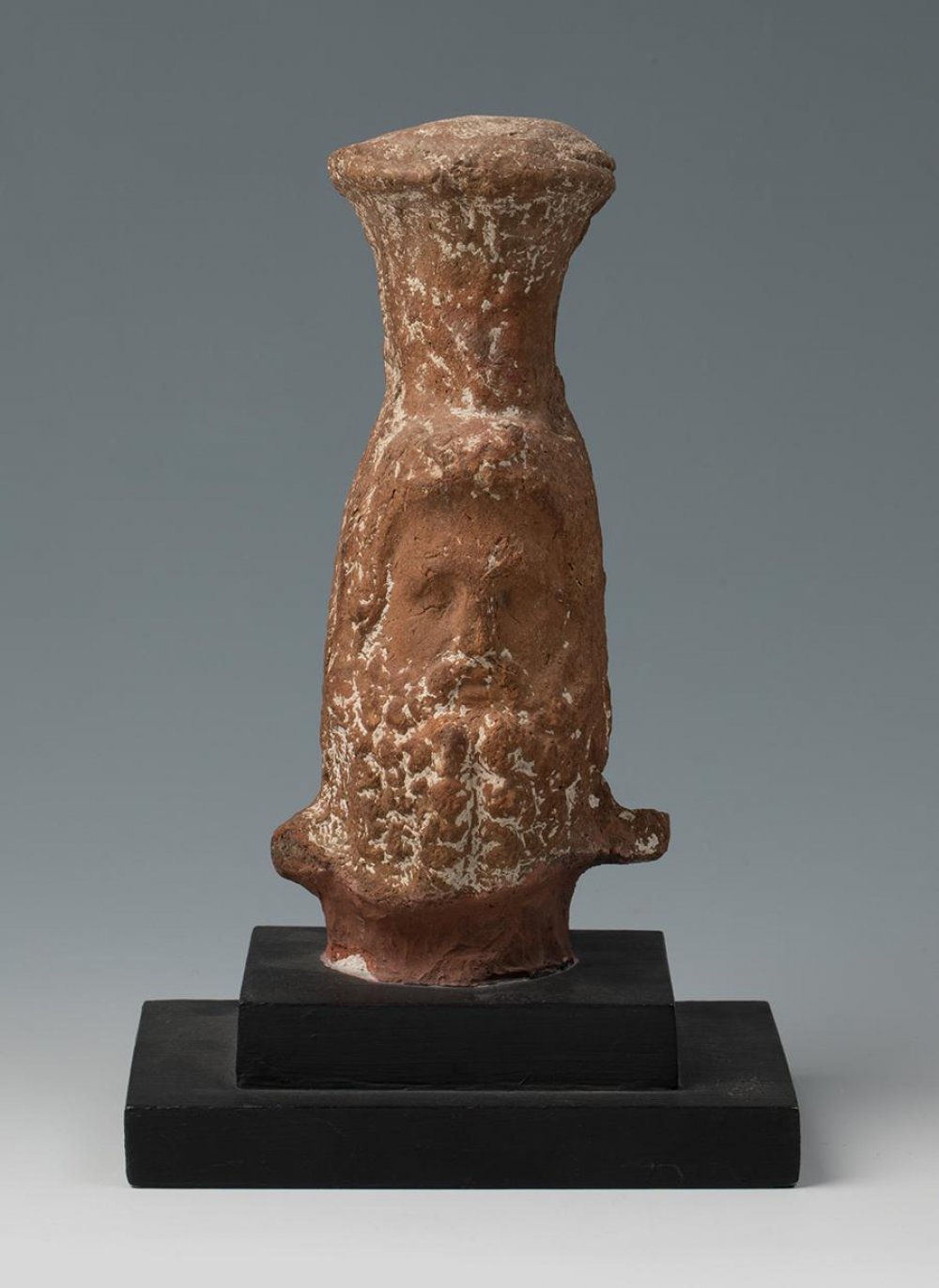162
Serapis; Rome, 1st-3rd century AD.Terracotta.It has material adhesions.It shows wear and tear.
Terracotta.
It has material adhesions.
It shows wear and tear.
Provenance: private collection (Madrid).
Measurements: 17.5 x 10 x 7 cm; 22 cm (base).
Modelled terracotta sculpture, dated between the 1st and 3rd centuries AD. The piece represents the god Serapis, with a beard and curly hair, worked with a trephine.Serapis was a Greek-Egyptian syncretic god, named patron saint of Alexandria and official god of Egypt and Greece by Ptolemy I (367-283 BC), with the aim of culturally linking both countries. According to Tacitus, Serapis was the god of Racotis, a town near Alexandria, and according to Strabo he was linked to the sacred Apis bulls (hence the name Serapeum of Saqqara of the necropolis where several of these bulls were buried). In fact, it originates from a combination of Osiris and Apis, the image of the dead Apis, which brings together the elements related to the underworld and fertility, thus allowing the Egyptian and Greek religions to be linked in a single deity. Thus, the earliest mention of Serapis is found in the account of Alexander's death (Arrian, "Anabasis", VII.26), where a temple dedicated to this god in Babylon is mentioned and his importance is emphasised by the fact that the dying king names him alone of all the gods. However, the chief god of Babylon was Zeus Belus (Baal Marduk), and it is difficult to imagine that he would have been assimilated to Serapis on this occasion. However, it is known that Ea, also called Sarapsi, the god of the deep ocean, of learning and magic, had a temple in the city. All doubts aside, the importance of Serapis in Alexander's last days may have determined the choice of the Egyptian Osiris-Apis to give the name and some of the main characteristics to the god of Alexandria. Serapis is thus an exemplary case of a syncretic divinity in which cultural practices of different origins are synthesised in a new image.as for his iconography, it is based on the first statue of Serapis, which was in the Serapeum in Alexandria. Of purely Greek origin, it had the attributes of Hades: the "modius" in the form of a crown (basket or grain meter, emblem of the underworld), a sceptre and, at his feet, the can Cerberus and a serpent. Although the bust presented here bears none of these attributes, it does resemble the original Serapis in his features to a great extent: a mature man with a concentrated face, fixed eyes, a bushy beard and moustache and long wavy hair. Even the way the cloak falls over his shoulders seems to derive directly from that model.
Terracotta.
It has material adhesions.
It shows wear and tear.
Provenance: private collection (Madrid).
Measurements: 17.5 x 10 x 7 cm; 22 cm (base).
Modelled terracotta sculpture, dated between the 1st and 3rd centuries AD. The piece represents the god Serapis, with a beard and curly hair, worked with a trephine.Serapis was a Greek-Egyptian syncretic god, named patron saint of Alexandria and official god of Egypt and Greece by Ptolemy I (367-283 BC), with the aim of culturally linking both countries. According to Tacitus, Serapis was the god of Racotis, a town near Alexandria, and according to Strabo he was linked to the sacred Apis bulls (hence the name Serapeum of Saqqara of the necropolis where several of these bulls were buried). In fact, it originates from a combination of Osiris and Apis, the image of the dead Apis, which brings together the elements related to the underworld and fertility, thus allowing the Egyptian and Greek religions to be linked in a single deity. Thus, the earliest mention of Serapis is found in the account of Alexander's death (Arrian, "Anabasis", VII.26), where a temple dedicated to this god in Babylon is mentioned and his importance is emphasised by the fact that the dying king names him alone of all the gods. However, the chief god of Babylon was Zeus Belus (Baal Marduk), and it is difficult to imagine that he would have been assimilated to Serapis on this occasion. However, it is known that Ea, also called Sarapsi, the god of the deep ocean, of learning and magic, had a temple in the city. All doubts aside, the importance of Serapis in Alexander's last days may have determined the choice of the Egyptian Osiris-Apis to give the name and some of the main characteristics to the god of Alexandria. Serapis is thus an exemplary case of a syncretic divinity in which cultural practices of different origins are synthesised in a new image.as for his iconography, it is based on the first statue of Serapis, which was in the Serapeum in Alexandria. Of purely Greek origin, it had the attributes of Hades: the "modius" in the form of a crown (basket or grain meter, emblem of the underworld), a sceptre and, at his feet, the can Cerberus and a serpent. Although the bust presented here bears none of these attributes, it does resemble the original Serapis in his features to a great extent: a mature man with a concentrated face, fixed eyes, a bushy beard and moustache and long wavy hair. Even the way the cloak falls over his shoulders seems to derive directly from that model.
9th of May - Archaeology
Sale Date(s)
Venue Address
General delivery information available from the auctioneer
Setdart offers Worldwide shipping
PICK UP IN ROOM: You can come and pick up your lots in our offices (Barcelona, Madrid or Valencia). At the moment of the withdrawal, you will be able to accept the current conditions of the lot by means of a document that you will sign.
YOU CAN SEND ANOTHER PERSON TO PICK UP: This person must present a signed authorization that you can find in our web page by accessing from BUY AT SETDART- LOGISTICS-DOWNLOAD AUTHORIZATION DOCUMENT. You can also send an e-mail with the requested data in AUTHORIZATION DOCUMENT to admin@setdart.com
Important Information
22% buyer´s premium
18% buyer´s premium at www.setdart.com
Terms & Conditions
The maximum period to pay the lots is 7 working days. You can pay either via bank transfer or with credit card through our platform www.setdart.com (we only accept VISA or Mastercard).
BUYER´S PREMIUM: 22% Hammer price + 21% VAT from the buyer´s premium
If your piece has more than 100 years, our Ministry of Culture requires an export certificate in order for the piece to leave the country. Note that if the piece goes inside the EU, there is no cost for the export certificate. If the piece goes outside the EU, there is a cost for the export certificate. You can find more information in our Ministry of Culture website: https://www.culturaydeporte.gob.es/en/cultura/patrimonio/exportacionimportacion/exportacion/tasas.html
INQUIRIES: admin@setdart.com
Setdart guides you through the entire process, from the time of award to the day you receive your lot. Our logistics team will be happy to manage your transport, and will advise you on the best shipping method with professionals from the sector used to handling works of art and jewelry.
WE OFFER WORLDWIDE DOOR TO DOOR SHIPPING
PICK UP IN ROOM: You can come and pick up your lots in our offices. At the moment of the withdrawal, you will be able to accept the current conditions of the lot by means of a document that you will sign.
YOU CAN SEND ANOTHER PERSON TO PICK UP: This person must present a signed authorization that you can find in our web page by accessing from BUY AT SETDART-LOGISTICS-DOWNLOAD AUTHORIZATION DOCUMENT. You can also send an e-mail with the requested data in AUTHORIZATION DOCUMENT to admin@setdart.com
SETDART IS NOT RESPONSIBLE FOR THE STATE OF THE PARTS ONCE THEY LEAVE OUR FACILITIES. MRW SHIPMENTS: Once the payment is made, your lot will be packed for shipment, the logistics department will send you an e-mail notifying you of the day it leaves our warehouse, changes of address cannot be made after receiving this e-mail.
INSURANCE INCIDENTS: Coverage for the value of the auction up to 3000 ? per shipment, if the value of the auction is higher, Setdart will send you a quote including the additional insurance. The insurance company WILL NOT BE RESPONSIBLE FOR THE SHIPMENT THAT EXCEEDS THAT AMOUNT AND IS NOT FULLY INSURED. MRW INCIDENTS: Maximum notification 48 hours after receipt, after which the insurance company WILL NOT BE RESPONSIBLE AND NO CLAIMS WILL BE ACCEPTED.
E-MAIL LOGISTICS: logistica@setdart.com
PICK UP YOUR MESSAGES: You can send your own messaging, prior notice via e-mail that your shipment is ready, please note 3 or 4 days in advance. This type of shipment is packaged so Setdart will provide you with a quote.
EXPENSES FOR STORAGE: We inform you that if the purchased lot is not picked up within a month, you will be charged 30€ per week per lot. Setdart Online S.L., owner of the web site "setdart.com", "setdart.net" and "setdart.org", acts as a company of Spanish nationality inscribed in the Volume 36955, sheet 182, page B-293056 of the Mercantile Registry, with registered office at Calle Aragó











